 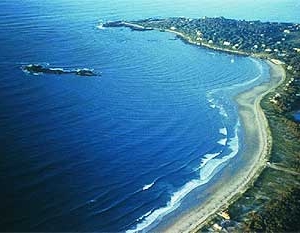 Refraction is the change in direction of a wave as it moves into a different material. A familiar example would be the apparent bending of the image of a spoon in a glass of water as the light passes from water to glass and then to air.
Refraction is the change in direction of a wave as it moves into a different material. A familiar example would be the apparent bending of the image of a spoon in a glass of water as the light passes from water to glass and then to air.In terms of waves in a large body of water like an ocean, the 'different material' is a region with different depth. Waves will change direction as they pass into an area at an angle, where the water is deeper or shallower. Let's look at how this works. First some definitions. 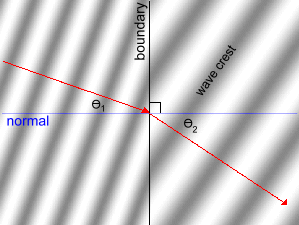 At the right are ocean waves moving from left to right, passing a boundary where the water changes from shallow to deep.
At the right are ocean waves moving from left to right, passing a boundary where the water changes from shallow to deep.The normal line is a line perpendicular to the boundary. The angle of incidence θ1 is the angle the incoming waves make with the normal. The angle of refraction θ2 is the angle the waves make with the normal after crossing the boundary. You can see here that θ2 is larger, indicating that the wave direction moved farther away from the normal line. When a surface water wave passes from one depth to another, it will refract. The frequency of the waves does not change, as this was predetermined by the original source of the waves. This means that the wave speed v and the wavelength λ are directly proportional to each other; as one increases, so does the other, according to the equation: v = f · λ where v is the wave speed, f is the frequency, and λ is the wavelength. The speed of the waves is a property of the medium in which they travel; in this case, the speed depends on the depth of the water. The wavelength may shorten or lengthen depending on the speed. Sound waves in air behave in a similar fashion, where the speed of sound primarily depends on the temperature of the air through which the sound waves travel. With light, the speed varies because of the varying optical densities of materials. The higher the optical density of a material, the slower a light ray moves through it. The lower the optical density, the faster the light propagates through it, with the fastest speed ocurring in a vacuum, where the wave speed is about 300,000 kilometres per second. Seismic wave refraction follows the same principle. If seismic waves from an earthquake travel more slowly in a material, they will be refracted upward. However, if the seismic waves travel faster in the next material, they will be refracted downward, until they reach a critical angle that will allow them to travel back to the surface. The different speeds and resultant path length differences allow an earthquake's epicentre to be located. The deeper the water, the faster a surface wave will travel, and the lower the height (amplitude) of the waves will be. As waves on the ocean come near shore where the depth is shallower, they slow down and get taller, preserving the amount of energy in the wave. For example, ocean tsunamis travel at about 960 kph in deep water, and may only be a few centimetres to a half metre high, making them very difficult to detect. When they reach the shoreline they are traveling much more slowly, but are much taller. Now let's look at some diagrams and animations of water waves passing from deep to shallow water. 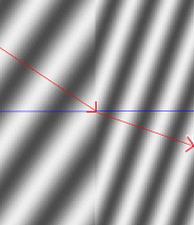 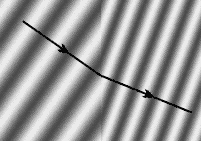
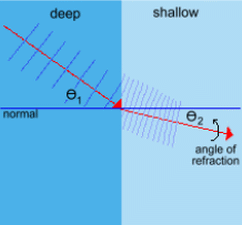
The waves are incident from the left, passing through deep water. They make an angle θ1 with the blue normal line. Their speed in deep water is higher, meaning the wavelength is also bigger. After crossing the boundary into shallow water, the wave direction changes, moving toward the normal with a smaller refraction angle θ2. Because they're now moving slower, the wavelength is also smaller. When waves move from shallow water to deep, everything is reversed. The slow moving, short wavelength shallow waves change direction at the boundary with deep water, moving away from the normal and now moving faster with a longer wavelength. 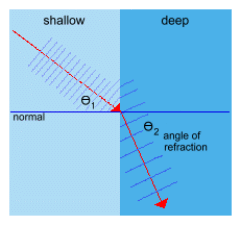
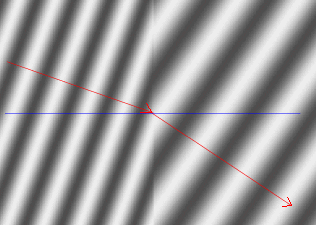
NOTE: We use the word 'speed' here, when it more properly should be called 'velocity', as the movement of waves has a direction. We're ignoring the difference here, since a wave's direction is not pertinent to the properties of waves. |